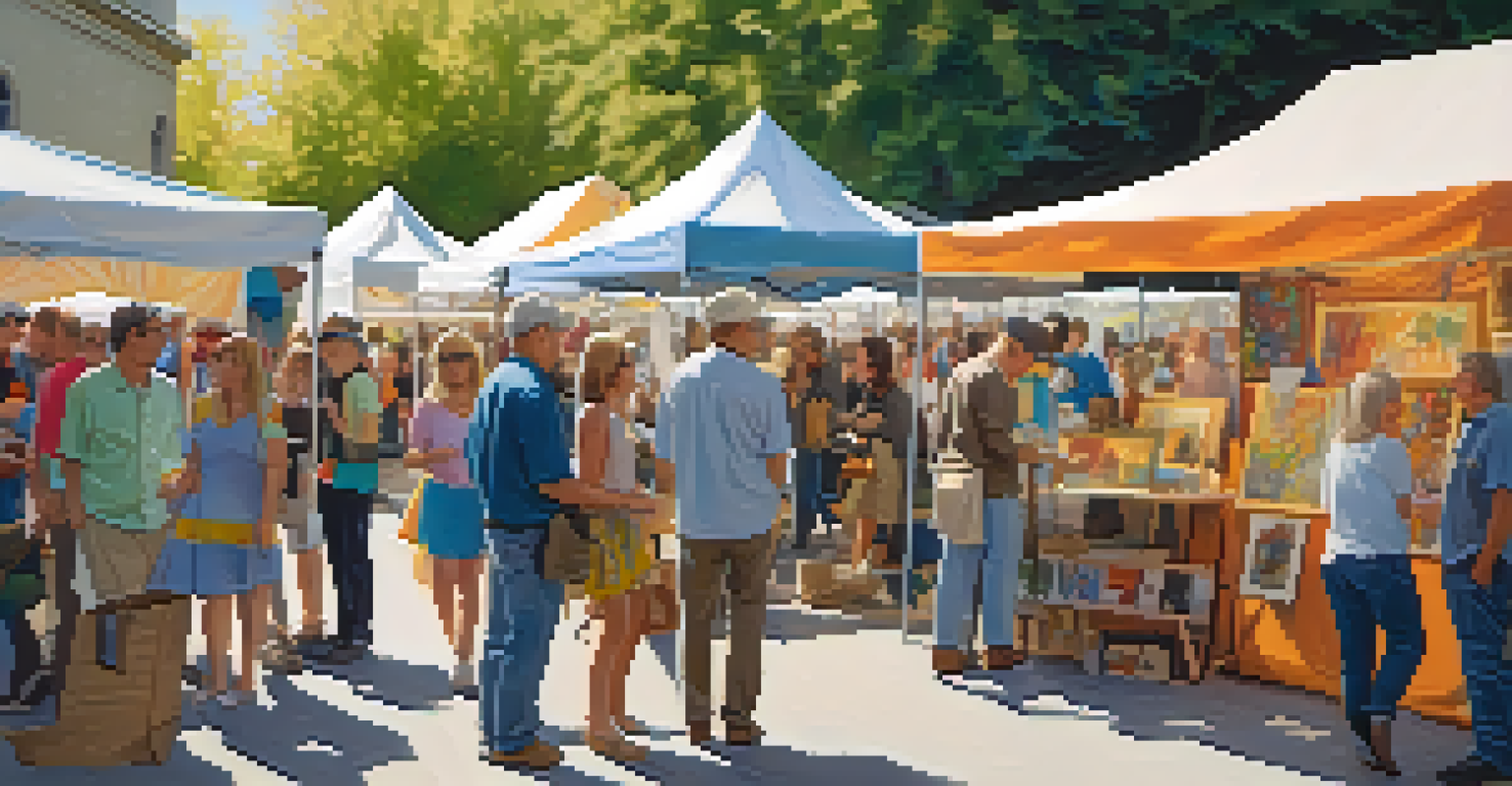The Role of Galleries in Selling Contemporary Art

Understanding the Contemporary Art Market
The contemporary art market is a vibrant landscape filled with diverse styles, mediums, and artists. It's crucial to grasp the dynamics of this market to appreciate the role galleries play in it. Galleries serve not just as exhibition spaces but as essential players in the intricate web of art sales, connecting artists with collectors and the public.
Art is not freedom from discipline, but disciplined freedom.
In recent years, the market has seen a shift towards more online platforms, but physical galleries still hold significant value. They create an immersive experience that online platforms can't fully replicate, allowing potential buyers to engage with the artwork on a personal level. This tactile interaction can spark emotional connections, which are often pivotal in making a sale.
Moreover, understanding current trends and the preferences of collectors is vital for galleries. They curate exhibitions that reflect these trends, showcasing works that resonate with both emerging and established tastes. This curation is an art form in itself, guiding buyers through a carefully crafted narrative.
The Gallery as a Curatorial Voice
Galleries do more than just display art; they act as curators with a distinct voice and vision. This curatorial role helps to shape how the public perceives contemporary art and influences what is considered valuable. By selecting which artists and artworks to showcase, galleries can elevate lesser-known artists into the limelight.

A well-curated exhibition tells a story that can captivate audiences and potential buyers alike. Through thoughtful placement and thematic groupings, galleries can enhance the narrative of an artist's work, making it more compelling. This storytelling aspect is essential in building a connection between the art and the viewer.
Galleries Connect Artists and Collectors
Galleries play a crucial role in bridging the gap between artists and collectors, providing exposure and fostering relationships that enhance the art-buying experience.
Furthermore, galleries often host events, such as openings and artist talks, which add depth to the viewing experience. These events create a community atmosphere, inviting dialogue and engagement, all of which can stimulate interest in the artworks on display. This community-building aspect is invaluable in fostering long-term relationships between artists, collectors, and the gallery.
Marketing Strategies Employed by Galleries
Marketing in the art world is unique and often requires a blend of traditional and innovative strategies. Galleries use a mix of social media, email newsletters, and public relations to reach potential buyers. By leveraging these platforms, they can showcase new exhibitions, highlight artists, and create a buzz in the art community.
The best artist has no conception that a marble block does not contain within itself.
In addition to digital marketing, galleries often collaborate with publications and influencers to gain exposure. This can include features in art magazines or partnerships with well-known figures in the art world. Such collaborations help to amplify their reach and establish credibility, making their exhibitions more appealing to collectors.
Moreover, galleries invest in building relationships with collectors, offering personalized experiences and insights. These relationships can lead to repeat business and referrals, as collectors often share their positive experiences with others. This word-of-mouth marketing is incredibly powerful in the art community.
Building Artist-Collector Relationships
Galleries play a pivotal role in fostering relationships between artists and collectors. By representing artists, galleries provide them with exposure and opportunities that may be difficult to achieve independently. This symbiotic relationship benefits both parties, as galleries gain exclusive access to unique artworks while artists receive valuable support and recognition.
Through events, exhibitions, and private viewings, galleries facilitate direct interactions between artists and collectors. These personal connections can significantly influence purchasing decisions, as collectors often prefer to buy art from artists they know or have met. This interpersonal aspect of art sales is invaluable in an industry where trust and relationships matter.
Digital Transformation in Art Sales
The rise of online platforms and virtual exhibitions is reshaping how galleries operate, allowing them to reach a global audience while maintaining the essence of physical art experiences.
Additionally, galleries help collectors understand the value of artworks, offering insights into the artist's background and the context of their work. This knowledge empowers collectors to make informed decisions, enhancing their buying experience. Ultimately, these relationships contribute to a more vibrant art ecosystem, benefiting artists, galleries, and collectors alike.
The Role of Exhibitions and Art Fairs
Exhibitions are a central component of a gallery’s strategy in selling contemporary art. They serve as platforms for artists to showcase their work and for galleries to attract potential buyers. Well-executed exhibitions can draw significant attention, often translating to sales during and after the event.
Art fairs, on the other hand, allow galleries to reach a broader audience beyond their local community. These events gather collectors, curators, and art enthusiasts from around the world, creating a dynamic marketplace. The exposure gained from participating in such fairs can lead to increased visibility for both the gallery and the artists they represent.
Moreover, exhibitions and art fairs provide galleries with opportunities for networking. Engaging with other galleries, artists, and collectors can lead to collaborations and partnerships that enhance their reach and impact. This interconnectedness is vital in the contemporary art world, where relationships often dictate success.
Navigating the Digital Transformation
The rise of digital platforms has revolutionized how galleries operate and sell art. Online galleries and virtual exhibitions have become increasingly popular, allowing collectors to browse and purchase art from the comfort of their homes. This shift has opened up new avenues for galleries to reach a global audience, breaking geographical barriers.
However, transitioning to a digital-first approach presents its challenges. Galleries must ensure that the online experience captures the essence of physical exhibitions, providing high-quality images and engaging descriptions. They also need to maintain the personal touch that in-person interactions provide, which can be tricky in a virtual setting.
Curatorial Influence Shapes Perception
Galleries act as curatorial voices, influencing public perception of contemporary art by thoughtfully selecting and presenting artworks that resonate with current trends and audiences.
To succeed in this digital landscape, galleries are adopting innovative strategies, such as virtual reality tours and live-streamed events. These technologies can create immersive experiences that mimic physical galleries, offering viewers a sense of presence. By embracing digital transformation, galleries can stay relevant and continue to thrive in a changing art market.
The Future of Galleries in Contemporary Art Sales
As the art market evolves, so too will the role of galleries in selling contemporary art. The integration of technology, changing consumer behaviors, and the demand for diverse perspectives will shape future gallery practices. Galleries that adapt to these changes while maintaining their core values are likely to succeed.
Moreover, there’s a growing emphasis on sustainability and social responsibility in the art world. Galleries that prioritize ethical practices, such as supporting underrepresented artists and promoting eco-friendly materials, will resonate with a more conscious audience. This shift toward inclusivity and responsibility will be key to attracting new collectors.

Ultimately, galleries will continue to be vital in connecting artists with collectors, fostering community, and driving the contemporary art market forward. By embracing change while honoring their heritage, galleries can ensure they remain relevant and influential in the ever-evolving landscape of contemporary art.